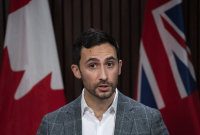Support strong Canadian climate journalism for 2025
On the day before the final weekend of summer break for two million students in Ontario, Laura Walton and the 55,000 other education workers with contracts negotiated by the Canadian Union of Public Employees (CUPE) were far from a collective deal to replace their recently expired labour agreements.
The same was true for the 60,000 teachers and education workers of the Ontario Secondary School Teachers' Federation (OSSTF) on the day after Labour Day, when the organization's president, Karen Littlewood, stood outside a North York high school to defend public education.
“We cannot allow this government, or any government, to set up a system for failure,” Littlewood said, pointing out that last year, a provincial auditor forecast a $12.3-billion shortfall in public education funding over the next nine years if current rates of investment continue. More recently, that same auditor said the provincial government spent $900 million less on education in 2021-22 compared to 2020-21.
As students and staff navigate a new school year with rising costs of living and without COVID-19 public health restrictions, Walton and Littlewood are among representatives from a handful of education unions sitting down to negotiate new labour deals with Premier Doug Ford's Progressive Conservative government in the coming months.
Both sides have stressed they want to deliver stability to students and their families after years of disrupted learning as they embark on what’s likely to be a drawn-out process, with each of the bargaining tables scheduled for scattered dates throughout September and October.
Education Minister Stephen Lecce issued a video statement on Tuesday promoting the government’s efforts to increase tutoring and mental health supports and upgrade classrooms.
“Together we’re going to get these kids back in a normal, in a more stable and a much more enjoyable school year, and I can’t wait,” he said.
Littlewood said OSSTF fought to cut a government push for four mandatory e-learning classes in high schools to two, with an opt-out during the last round of negotiations, which wrapped up soon after COVD-19 hit. Students and parents who struggled through online learning valued such efforts, she said.
“We are not the ones looking to sell out on students’ interest,” she said. “It's educators and education workers who deliver the stability that students and their families deserve.”
The OSSTF expects to get a better idea of what the government plans to offer at meetings next week, when CUPE will return to talks after going public with the government’s opening offer last month.
Walton, an educational assistant and the president of CUPE's Ontario School Boards Council of Unions (OSBCU), said the government had not scheduled enough negotiations to work through the issues at play.
The OSBCU represents educational assistants, school library workers, custodians and other school staff who earn an average of $39,000 a year.
The union filed its notice to bargain in early June, the day after the Progressive Conservatives returned to government with an enlarged majority. It later went public with its own detailed proposal that included a sharp increase in pay to make up for a decade of effective pay cuts, to which the government counter-offered much less.
“My co-workers and I are fighting for every four- and five-year-old to get the play-based learning support that is so necessary,” said Walton, in a push to get an early childhood educator in every kindergarten classroom.
“We are fighting for decent wages, increase services for students and a reinvestment in public education.”
Morgan Sharp / Local Journalism Initiative / Canada’s National Observer






Comments